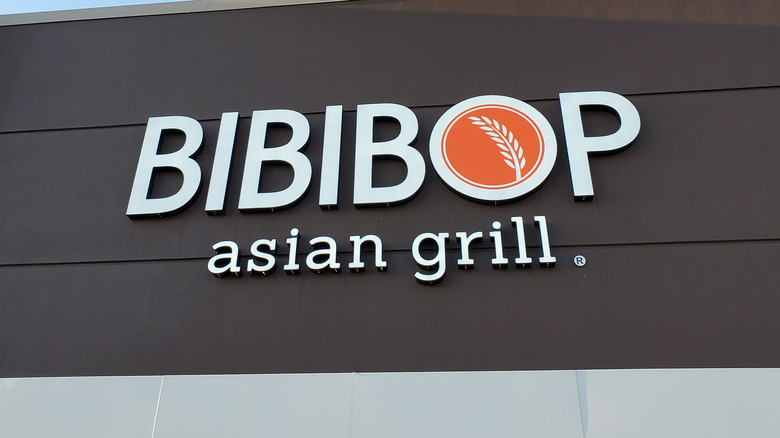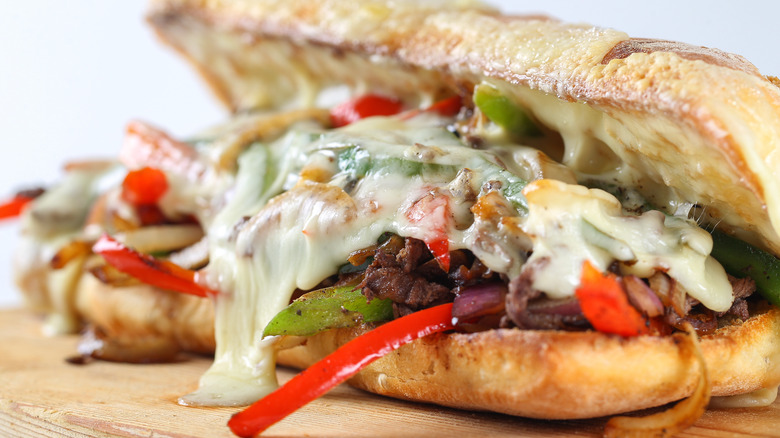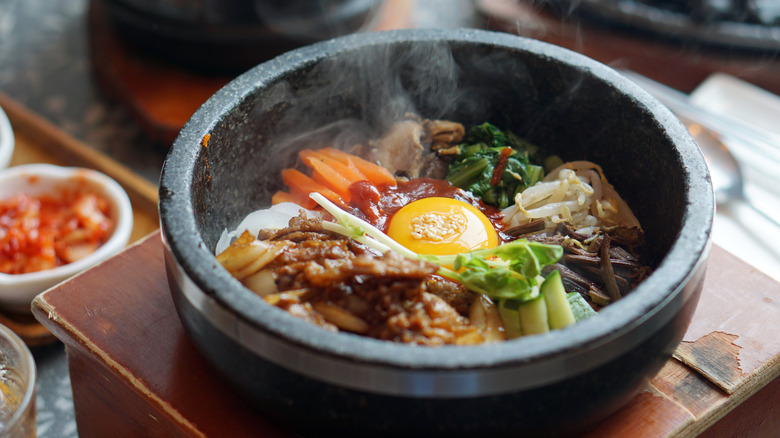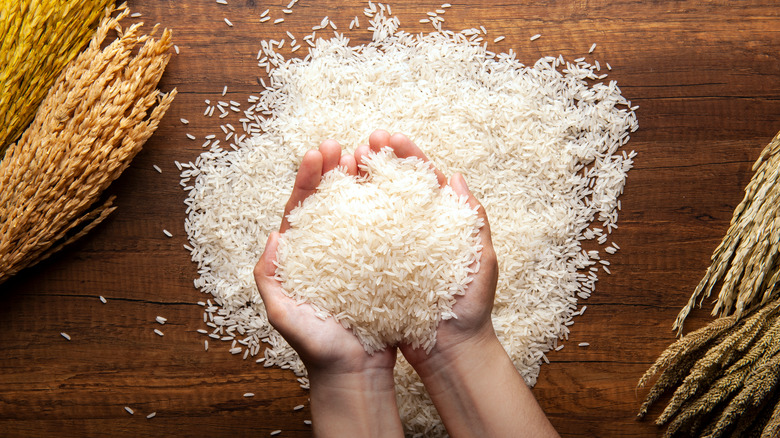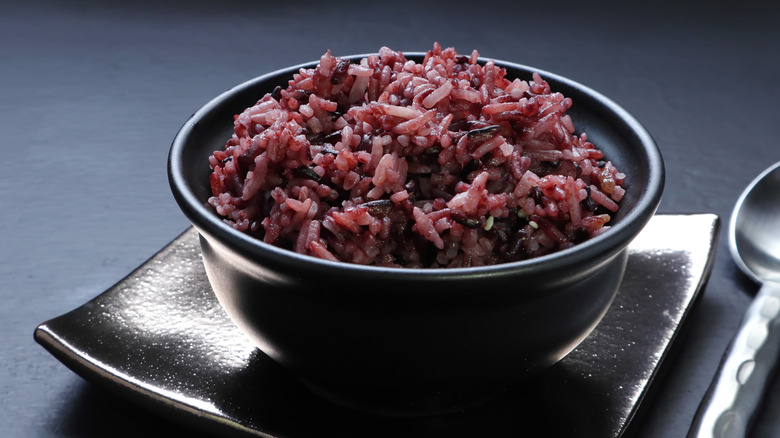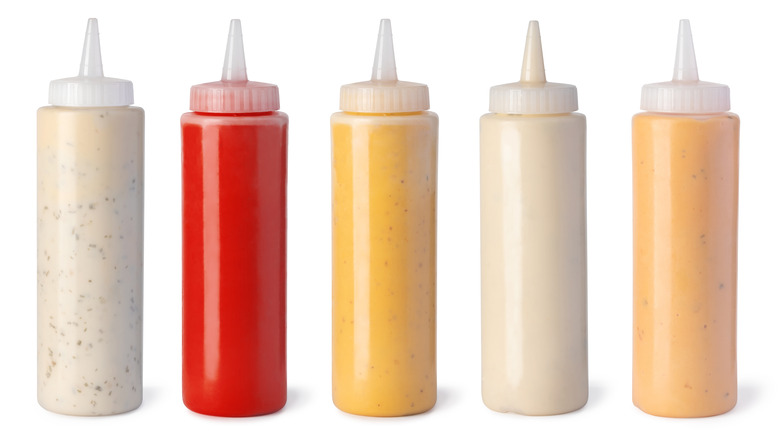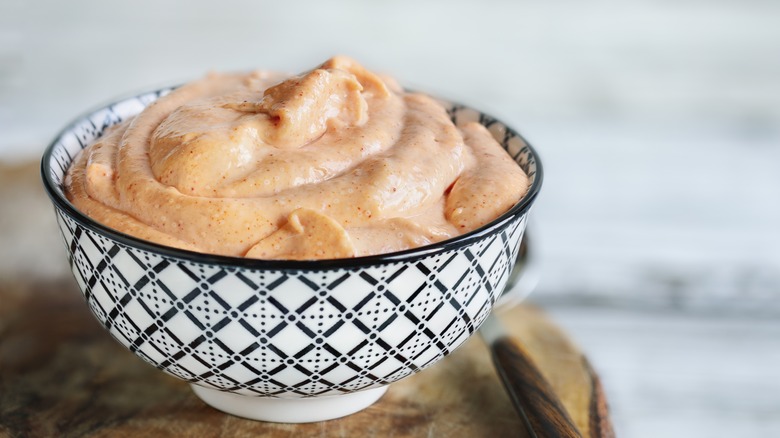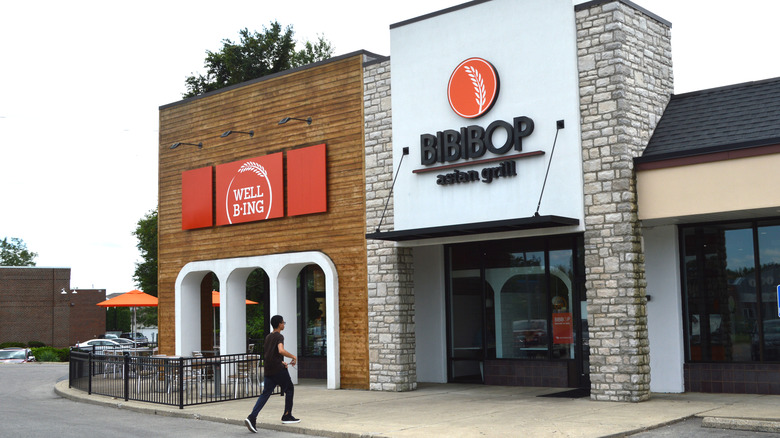The Untold Truth Of Bibibop
We may receive a commission on purchases made from links.
If you are familiar with Bibibop Asian Grill, you are likely already in love. And if you are not, then you are in for a treat. Since its founding in August of 2013, with just one location in Columbus, Ohio, Bibibop has quickly grown to include restaurants in eight states plus the District of Columbia. There are Bibibops on both the West and East Coasts. That's pretty impressive for a fast casual restaurant chain that is entirely privately owned with zero franchises.
The basic premise is not only simple but has proven successful in similar, well-established restaurants like Chipotle and Subway. You start with a base of either rice, greens, or noodles, then add toppings, a protein (meat or tofu), and a sauce. Finally you mix it all together and savor your freshly made meal.
So what is Bibibop's secret? How did a restaurant based on the promotion of holistic living and contentment (what Bibibop calls Well B-ing) become so popular? Read on to uncover all the answers.
It all started with Philly cheesesteaks ... and a prayer
Bibibop's founder and CEO, Charley Shin, was born and raised in Seoul, South Korea. He came to the United States in the mid-1980s to attend Ohio State University in Columbus, Ohio. It is there that he first tasted a Philly cheesesteak, and his taste buds fell in love. Shin was ambitious even as an undergrad, and before graduating from college, he founded what is now an international restaurant chain, Charleys Cheesesteaks.
Charleys Cheesesteaks are mostly based in retail settings, like malls and airports. After 30 years of success, Shin wanted to expand beyond that style to detached independent restaurants, but he ran into difficulties. Being a devout Christian, Shin decided to pray on it — for three hours.
Shin felt moved to go in an entirely new direction with a restaurant based on a healthy lifestyle. He and his sister, Chung, spent the better part of a year taste-testing recipes and devising a totally unique menu. Thus Bibibop Asian Grill and its Well B-ing concept were born.
Founder and CEO Charley Shin was inspired by his mom
Not only was Shin aided by his sister, but he was also inspired (and greatly supported) by his mother. Before launching Charleys Cheesesteaks in Ohio, making and serving food was not new to him. Before moving to the U.S., Shin worked as a teenager in his mother's restaurant in Seoul where they served traditional Korean dishes. His mother must have had a lot of faith in her son because Shin convinced her to invest her entire life savings into his cheesesteaks venture. Lucky for both of them it paid off.
When it came to envisioning what would become Bibibop, Shin returned to his roots. He imagined not a traditional Korean restaurant because he didn't believe it would broadly appeal to the American palate. Instead, Shin settled on a sort of fusion of the two countries. The idea of a traditional bowl of bibimbap was blended with foods more familiar to Americans, such as roasted broccoli, corn, potatoes, cheese, and pineapple. (The name Bibibop is a play on bibimbap.)
Bibibop is based on a beloved Korean dish
So what is bibimbap? Simply put, bibimbap is a bowl of cooked white rice with toppings, typically vegetables and meat, that are all mixed together before consuming. Adding an egg is also popular. The literal translation of bibimbap to English is "mixed cooked rice," bap being the Korean word for cooked rice.
No one is really sure where bibimbap originated, but it seems to have evolved over the past 400 years into the dish we have today. It's difficult to trace its history partly because of the switch in writing systems, from using Chinese characters to the syllabic Hangul system used today. There are also several variations of bibimbap within Korea (both North and South) depending on the availability of ingredients and region.
With such a long and rich history, it's easy to see how Shin was able to bring this beloved dish to the U.S., incorporating ingredients commonly found in the American diet.
Every location is certified gluten-free
Because bibimbap is based on rice, vegetables, and meat, it is naturally gluten-free (provided soy sauce is not used). Bibibop has taken the extra step to become a Validated Gluten-Free Safe Spot as certified by the Gluten Intolerance Group (GIG). GIG is a non-profit that has worked to support a gluten-free lifestyle for nearly 50 years. They offer several different resources for both individuals and food professionals.
The noodles found on Bibibop's menu are made from sweet potato starch, not wheat flour, and are known as dangmyeon in Korean. Also commonly called cellophane or glass noodles in English, they are the basis of another popular Korean dish, japchae. Japchae is similar to bibimbap in that it is also a mixture of a starch base with meat and vegetables, but japchae is stir-fried rather than piled into a bowl and mixed just before eating, like bibimbap is. So these noodles are a natural fit for Bibibop's signature bowls.
Bibibop celebrates #MeatlessMonday
Studies have shown that a plant-based diet can have positive impacts on a person's health. We're talking lower risks of diabetes and heart disease, lower blood pressure, and a lower likelihood of developing some cancers. And there is the environmental impact of eating (and producing) meat. Increased greenhouse gasses like CO2 and exorbitant water consumption both greatly contribute to climate change.
So it's no wonder that movements like Meatless Monday have become trendy. More and more restaurants are getting involved by offering vegetarian and vegan options on their menus and promoting the hashtag #MeatlessMonday. Bibibop has had meatless options since the very beginning. And on Mondays, it offers a 20% discount on every tofu or veggie bowl. When ordering online, there are even Meatless Monday options listed to make it even easier to go meat-free. (They are only made available on Mondays, however, and the rest of the week you won't find them on the menu.)
The Bibibop app promotes healthy living
Apps are all the rage these days, and for a modern restaurant, they are simply a must. They are made worth the download to consumers through bonuses like reward programs and the convenience of ordering ahead. Bibibop's app offers both of these. Submit your order on the app, and pick it up when you arrive. Every dollar spent earns you one point, and 100 points can be traded in for a $5 discount that can be redeemed at any location or online. Pretty routine as far as fast casual restaurant apps go.
However, Bibibop had to add its own twists. Remember, they are committed to promoting a healthier lifestyle, so their app offers special Well B-ing Challenges. You can also earn rewards by inviting friends to also join with your unique code, receive a free gift on your birthday, check out the latest from the Bibibop blog, and get nutrition information on menu items.
The purple rice is high in antioxidants
Rice comes in many different colors. One of Bibibop's bowl bases is traditional Korean purple rice. In this case, the rice grains themselves are not purple. It is actually a blend of white rice and black rice. When cooked together, the black rice stains the white rice, resulting in a purple color. The higher the ratio of black rice to white, the darker the color.
The actual pigment is called anthocyanin, which is widely believed to be an antioxidant. Anthocyanin has been linked to reduced heart disease risk and decreased inflammation. It may also be good for the heart and eyes. Black rice is also higher in protein than brown rice, and a ¼ cup serving contains 6% of the daily recommendation of iron.
Black rice was once restricted to only the Chinese aristocracy, which is why you sometimes see it called "forbidden rice." Now it can be found in most grocery retail stores.
Many employees say Bibibop is a good work environment
With Bibibop constantly opening new locations and innovating, such as opening its first drive-thru restaurant, there are many employment opportunities with this company. Happily, it is consistently rated as a fun place to work on sites like Indeed and Glassdoor, where it has an overall score of 3.8 out of 5 stars. CEO Charley Shin has an approval rating of 75%. And 67% of Glassdoor reviewers would recommend their job at Bibibop to a friend.
One current manager in University Heights, Ohio admitted to enjoying their job, even with the fast-paced work environment, and said the pay was decent. Another manager declared Bibibop a good place to work for students, and a former employee called it a good entry-level position.
A Bibibop restaurant manager can make up to just shy of $56k per year. A full-time regular team member can expect to make around $24k per year.
Its signature sauces are available for purchase
A condiment that really makes the bowls at Bibibop stand out and pop with flavor is the restaurant's line of sauces. Did you know though that Bibibop bottles and sells its own signature sauces? Yes, that's right, you can enjoy, in the comfort of your own home, the Bibibop Yum Yum, Spicy Yum Yum, Sesame Ginger, and Honey Gochujang sauces on any food of your choosing. The Yum Yum sauces make terrific dips for vegetables, seafood, French fries, and more. Plus, any of the four sauces would make perfect dressings for a green salad.
Sixteen-ounce bottles are available for purchase at Walmart Supercenters and Walmart Neighborhood Markets even in places that don't have a Bibibop close by. You can also purchase them through Walmart's website or on Amazon. The Sesame Ginger sauce is vegan, and all four sauces are gluten-free.
Unfortunately, there is no word yet on if one of the other sauces, like the Teriyaki or Yuzu Vinaigrette, will be hitting the shelves any time soon.
While delicious, Yum Yum sauce is not Asian in origin
What is now frequently called yum yum sauce didn't start off with that name. Or any specific name. Because no one is really sure where it originally came from. A mayonnaise-based sauce that is popular at hibachi restaurants across the U.S., yum yum sauce is not in fact Japanese. It's true that mayonnaise is quite popular in Japan, and that it differs from American mayonnaise. But yum yum sauce is not straight up mayo, Japanese or otherwise. The flavor is universally described as sweet and tangy.
Other names that you often see it called are white sauce, because of the light color, and shrimp sauce, though there is no shrimp in the sauce. Recipes and ingredients for yum yum vary across restaurants and regions, but there is no denying the hold it seems to have over restaurant-goers, so perhaps yum yum sauce really is the most appropriate name.
Omija tea is a traditional Korean health tonic
One of Bibibop's beverage options is iced Berry Omija Tea. Korean omija berries have multiple names, schisandra and five flavor berries (because it is said to express all five flavors) being the two most common.
Omija is an adaptogen, meaning it supports the body's resistance to stress, whether that be physical, mental, or emotional in nature. In traditional Chinese medicine, where it is called wu wei zi, it is used to treat persistent coughs and hyperhidrosis (excessive sweating) among other things. Studies have shown that omija is also great for the liver, improving its function over time.
A concentrate can be made from the berries that can then be mixed into different liquids to create a refreshing drink. But Dr. Lee Ga-soon of the South Chungcheong Province Agricultural Research and Extension Services found that to enjoy the most benefits this berry has to offer, the whole berry should be consumed, seeds and all.
Bibibop is a rising star
Bibibop Asian Grill was not deterred by the COVID-19 pandemic that paralyzed so many businesses across the U.S. Neither were its sibling restaurant chains, Charleys Cheesesteaks and Lennys Grill & Subs. The brand's parent company, GOSH Enterprises, Inc. had plans to open 100 new restaurants in 2021 between its three chains. Fifteen of those locations were Bibibops.
In 2017, Bibiop had 25 locations and systemwide sales came to an incredible $23 million according to Restaurant Business Magazine. At the beginning of 2022, there were 43 locations. In 2019, Money Inc called Bibibop a business to keep an eye on, and they were not kidding. Going from a single brand new restaurant to 43 in less than a decade is remarkable by anyone's standard. And all of this without the help of franchises.
There are still 42 states that don't have a Bibibop. If yours is one of them, and you'd like to argue why it shouldn't be, Bibibop invites you to contact them on their website to plead your case.
